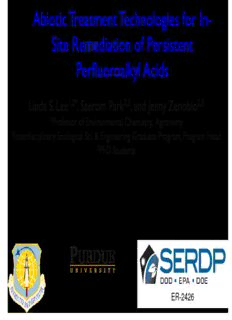
pdf 20.01.2016 50_Research abiotic treatment 2015 Linda S. Lee/Saerom Park/Jenny Zenobio PDF
Preview pdf 20.01.2016 50_Research abiotic treatment 2015 Linda S. Lee/Saerom Park/Jenny Zenobio
Abiotic Treatment Technologies for In- Site Remediation of Persistent Perfluoroalkyl Acids Linda S. Lee1,2*, Saerom Park2,3, and Jenny Zenobio2,3 1Professor of Environmental Chemistry, Agronomy 2Interdisciplinary Ecological Sci. & Engineering Graduate Program, Program Head 3PhD Students June 26, 2015 NICOLE Workshop Manchester, UK Office of the ER-2426 Vice President Aqueous Film-Forming Foam (AFFF) Sources US Military big user of AFFFs, which are a primary source of PFAAs and likely present at > 550 sites. Additional, many other military sites due to use/releases of AFFFs to extinguish hydrocarbon fires or industrial activities, etc. PFAAs are persistent, bioaccumulative, and relatively mobile. Provisional health advisory ● levels are well below what is expected at military sites ● Currently, no viable in-situ technology has been successfully demonstrated for the entire suite of PFASs, particularly linear * * * PFOS, or PFAA precursors. *Moody and Field, 1999; Moody et al., 2003; Schultz et al., 2004 PFASs in Aqueous Film Forming Foams (AFFFs) (Place & Field, EST, 2012) Electrofluorination-based fluorinated surfactants B, C & D Telomer-based fluorinated surfactants Terminal microbial end products Perfluorosulfonic acids Perfluorocarboxylic acids PFSAs (PFOS pK < 0) a PFCAs (PFOA pK < 4) a Σ = PFAAs = perfluoro alkyl acids Initial Approach: Chemical Oxidative Treatment Fenton’s Reagent ◦ Thermodynamic studies indicate not effective ◦ PFOS not degraded with an aggressive treatment. Ultraviolet reactions ◦ Successful for only PFOA ◦ Conditions not applicable in situ Permanganate ◦ some success with PFOS at ≥ 65 ºC & low pH (Liu et al, 2012) Sonolysis ◦ Good results for PFOA and PFOS ◦ Not applicable for in situ Persulfate ◦ UV and heat activation established successful for PFOA (Hori et al., 2005; Lee et al, 2012; Liu et al., 2013) *Choice of activation mode dependent on effectiveness and efficiency for a given environment, e.g., in-situ versus ex-situ. Heat-activated Persulfate for 3 Representative PFASs Experimental Variables PFOA/PFOA- Temperature (20 ~ 60 °C) ↔ - Unbuffered pH Persulfate (Na S O ) Conc. 2 2 8 PFOS- (0 ~ 20,000 mg/L, 84.00 mM) PFACs conc. (50 ~ 2,500 µg/L, 0.12 µM ~ 6 µM) Fuel co-contaminants 6:2 FTS (6:2 Fluorotelomer sulfonate) (BTEXs up to 1,000 µg/L) Aquifer Heat-Activated Persulfate (100 µg/L PFOA) Varying Temperature Varying [Na S O ], T = 50 ºC [Na S O ] =- 10,000 mg/L 2 2 8 2 2 8 This Study (unadjusted pH) 0.25Lee et al. (2012) pHo=2.5 20 C 30 C 40 C 50 C Lee et al. (2012) pHo=7.1 Lee et al. (2012) pHo=11 0.20 Liu et al. (2012) pHo=7.1 1.0 )-2 1 0.15 0.8 - h ) 1( Co0.6 -, h1k-140.10 / (k- Ct0.4 n -60.05 l 0.2 -80.00 0.0 0.0028 0 01.000320 03.0003420 500.006340 700.008306 90 0 50 100 150 200 250 300 350 N1a/(T,S K)O (mM) 2 2 8 Time (h) Removal rate ↑ with ↑ temperature and ↑ [Na S O ] 2 2 8 Linear Arrhenius Plots (right graph) Unbuffered pH (pH decreases with reaction) Same for PFCA range tested: 50 ~ 2,500 µg/L (0.12 µM ~ 6 µM) Heat (50 ºC) - Activated Persulfate [Na S O ] – 10,000 mg/L, 50 ºC 2 2 8 ~100 µg/L M) (0.241 µM) PFOA ~100 µg/L (0.215 µM) 6:2 FTS PFOA and 6:2 FTS unzipped to smaller PFCAs Eventually complete abiotic mineralization (F- and CO ) 2 Co-contaminants (@ 1000 mg/L) - PFAS degradation NOT affected Heat-Activated Persulfate PFOS (100 µg/L) 1.0 0.8 60.5 mM NaS2O8 ) M 0.6 No Oxidant Contorl µ ( S O0.4 F P 0.2 0.0 0 20 40 60 80 100 Time (h) • PFOS unaltered at 90 C with 60.5 mM Na S O as well as at 2 2 8 90 C with 84 mM Na S O 2 2 8 • PFOA & PFOS will coexist in groundwater, thus technologies that can remediate both are needed Persulfate Oxidation - Yang et al. (2013) 100,000 µg/L PFOS (0.2 mM) doi:10.1371/journal.pone.0074877.g006 • High PFOS concentration (0.2 mM PFOS = 3.4 mM Fluoride) • High persulfate concentration and no controls presented • Hydrothermal (HT) – high temperature and pressure • Other literature: Kingshott (2008) Thesis – probing using reactant concentrations approaching solubility limits Method Development Approach for successful exploration requires: Accurately quantify target parent PFAS (and isomers) ◦ High extraction efficiencies of all phases ◦ Reliable chromatographic separation and detection Accurately quantify fluoride and sulfonate metabolites ◦ Above background noise ◦ Optimize nanocomposite synthesis to minimize background ◦ Minimize analytical matrix effects ◦ High extraction efficiencies and appropriate analytical methods Identify organic metabolites and quantify if possible ◦ TOF, MS/MS probing of aqueous and extractants ◦ Headspace sampling (requires airtight reaction vessel) Analytical methods are treatment technique dependent
Description: